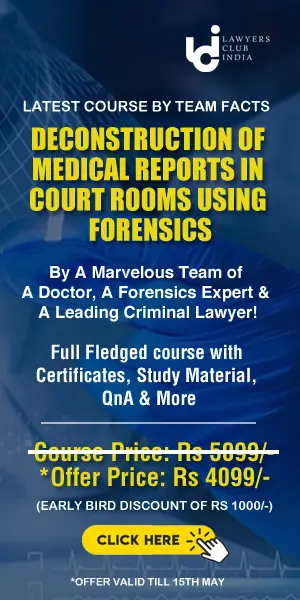Case title:
Noble M. Paikada v. Union of India
Date of Order:
21st March 2024
Bench:
Hon’ble Mr. Justice Abhay S. Oka
Hon’ble Mr. Justice Sanjay Karol
Parties:
Appellant: Noble M. Paikada
Respondent: Union of India
SUBJECT:
The Hon’ble Supreme Court of India (hereinafter referred to as ‘the Supreme Court’ or ‘the Court’) dealt with a case challenging the legality of certain exemptions granted by the Ministry of Environment and Forests (MoEF) under the Environment (Protection) Act. The contested notification exempted the extraction of ordinary linear projects from the need to obtain prior Environmental Clearance (EC). The Supreme Court held the contested provisions arbitrary and violative of Article 14 and subsequently struck it down.
IMPORTANT PROVISIONS:
The Constitution of India, 1950:
- Article 14: deals with equality before the law or equal protection of law within the territory of India
- Article 21: guarantees the fundamental right to protection of Life and Personal Liberty.
The Environment (Protection) Act 1986, (EPA):
- Section 3: deals with the powers of the central government to take measures to protect and improve the environment.
The Environment (Protection) Rules 1986, (EP Rules):
- Rule 5: deals with standards for emission or discharge of environmental pollutants.
The Mines and Minerals (Development and Regulation) Act 1957, (MDR):
- Section 8
OVERVIEW:
- The Ministry of Environment and Forests (MoEF) issued a notification on 14.09.2006 under section 3 of the EPA, read with Rule 5 of the EP Rules (first EP notification) which provided that projects will be categorized under categories A and B in the Schedule, mandating prior Environmental Clearance (EC) from the Central Government for Category A projects and from State Environment Impact Assessment Authority (SEIAA) for category B projects.
- Subsequent modifications were made to the 1st EP notification, through the 2nd EP notification issued on 15.01.2016. Clause 7B and Appendix-IX of the 1st notification provided for an exemption to specific categories of projects from the requirement of obtaining the Environment Clearance (EC).
- The MoEF substituted Appendix-IX, resulting in the exemption of 13 cases from prior EC requirements through the impugned notifications.
- Modifications in the EC notifications were challenged before the National Green Tribunal (NGT) on 28.03.2020 (impugned notification). Items 6 & 7 within the substituted Appendix-IX were contested on grounds of legality and implications of the exemptions of EC in specific cases.
- Review petitions were filed which sought reassessment of the impugned notification and its compliance with environmental laws and regulations.
- NGT struck down a part of the 2nd notification but made no changes in Appendix-IX. It disposed of the application and directed the MoEF to revisit the impugned notification.
- Appeals were filed against the NGT’s judgment before the Supreme Court, seeking further review of the impugned notification, the exemptions provided, and their legality.
ISSUES RAISED:
- Whether the inclusion of items 6 & 7 in the Appendix - IX was made without due consideration for environmental safeguards and public participation?
- Whether the impugned provisions provided private miners and contractors undue advantage and lacked public consultation.
ARGUMENTS ADVANCED BY THE APPELLANT:
- The provisions of the impugned notification are violative of Rule 5 of the EP Rules and against public interest and were issued with undue haste, especially during the COVID-19 pandemic lockdown, and was a display of undue favouritism towards private miners and contractors.
- The exemption granted in item 6 of the impugned order was unspecific and lacked safeguards, rendering it arbitrary and violative of Article 14 of the Constitution. Reliance was placed on the ruling in the case of Deepak Kumar & Ors v. State of Haryana to support this argument.
- The lack of regulatory mechanisms ensuring compliance with the stipulated Standard Operating procedure (SOP) and environmental safeguards mentioned in the notification.
- Despite NGT’s specific directives, sufficient measures concerning the mode and manner of excavation and quantum, were not implemented.
- Referring to the case of Hanuman Laxman Aroskar v. Union of India, it was argued that the blanket exemption provided in the impugned notification defeated the object of the enactment of EPA.
ARGUMENTS ADVANCED BY THE RESPONDENT:
- The impugned notification was in compliance with EPA, EP rules, and other relevant laws.
- The exemptions provided in the notification were mandated to facilitate the smooth functioning of projects in various sectors including potters, farmers, and non-mining activities.
- An office memorandum addressing the NGT’s concerns had already been issued, thereby negating any need for further action.
JUDGEMENT ANALYSIS:
- The Supreme Court opined that citizens played a crucial role in matters relating to the environment and therefore their participation cannot be casually dismissed.
- Further, it was noted that the Ministry failed to produce the documents recording the competent authority’s satisfaction with the existence of public interest, dispensing the requirement of prior notice under Rule 5 of EP Rules.
- The invocation of Rule 5(4) lacked proper application of mind, rendering it vitiated.
- The Court found the hasty issuance of the impugned notification during lockdown to be undue and inappropriate. The inclusion of item 6 of the substituted Appendix-IX was held to be illegal.
- The usage of terms like ‘linear projects’ in the notification was deemed vague and lacking in specified processes for excavation.
- The exemption provided under item 6 is a representation of an entirely unguided and blanket exemption, rendering it arbitrary and in violation of Article 14. Moreover, there was no framework in place establishing an authority that would determine the applicability of item 6. Thus, it was declared arbitrary.
- The absence of regulatory machinery ensuring compliance with the standard operating procedure (SOP) and environmental safeguards was noted by the Court along with the inadequacies of safeguards regarding excavation processes and quantum.
- The Supreme Court refrained from addressing item 7 of the impugned notification because none of the respondents contested it. Therefore, the respondents will have to comply with the directions of the impugned judgment regarding item 7.
- Subsequently, item 6 of the notification was struck down in both notifications (2020 and 2023).
CONCLUSION
The Supreme held the inclusion of item 6 in Appendix-IX in the impugned notification to be arbitrary and in violation of Article 14 of the Constitution of India due to its blanket exemption and lack of regulatory oversight. It was held that the safeguards regarding the processes and quantum of excavation were inadequately provided despite specific directions of the NGT. This reinforces the significance of adhering to due process, transparency, and environmental safeguards in policy formulation. The Apex Court’s ruling aims at prioritization of sustainability and inclusivity in decision-making processes while respecting judicial scrutiny and public participation in environmental matters. The appeals were partly allowed with no order as to costs.















